Contemporary Indigenous Health and Wellbeing: Guided Reflection Report
VerifiedAdded on 2022/11/17
|10
|2664
|472
Report
AI Summary
This report is a guided reflection on the student's experiences and learning within a Contemporary Indigenous Health and Wellbeing (CIHWB) course, focusing on interactions with Aboriginal and Torres Strait Islander peoples. The student utilizes the Gibbs Cycle for reflection, detailing their experiences in the 'yarning circle' activities, including a documentary about Aboriginal policies and a video on health challenges. The student reflects on their initial stereotypical views, recognizing the historical and social factors impacting Indigenous health. The report also covers an Indigenous Organization presentation, highlighting barriers to accessing services and the importance of teamwork. The student concludes by discussing the importance of cultural competence in nursing practice and plans for improving communication skills to better serve Indigenous communities, referencing course materials and UTS attributes of nursing. The assignment showcases the evolution of the student's understanding and commitment to culturally sensitive healthcare.
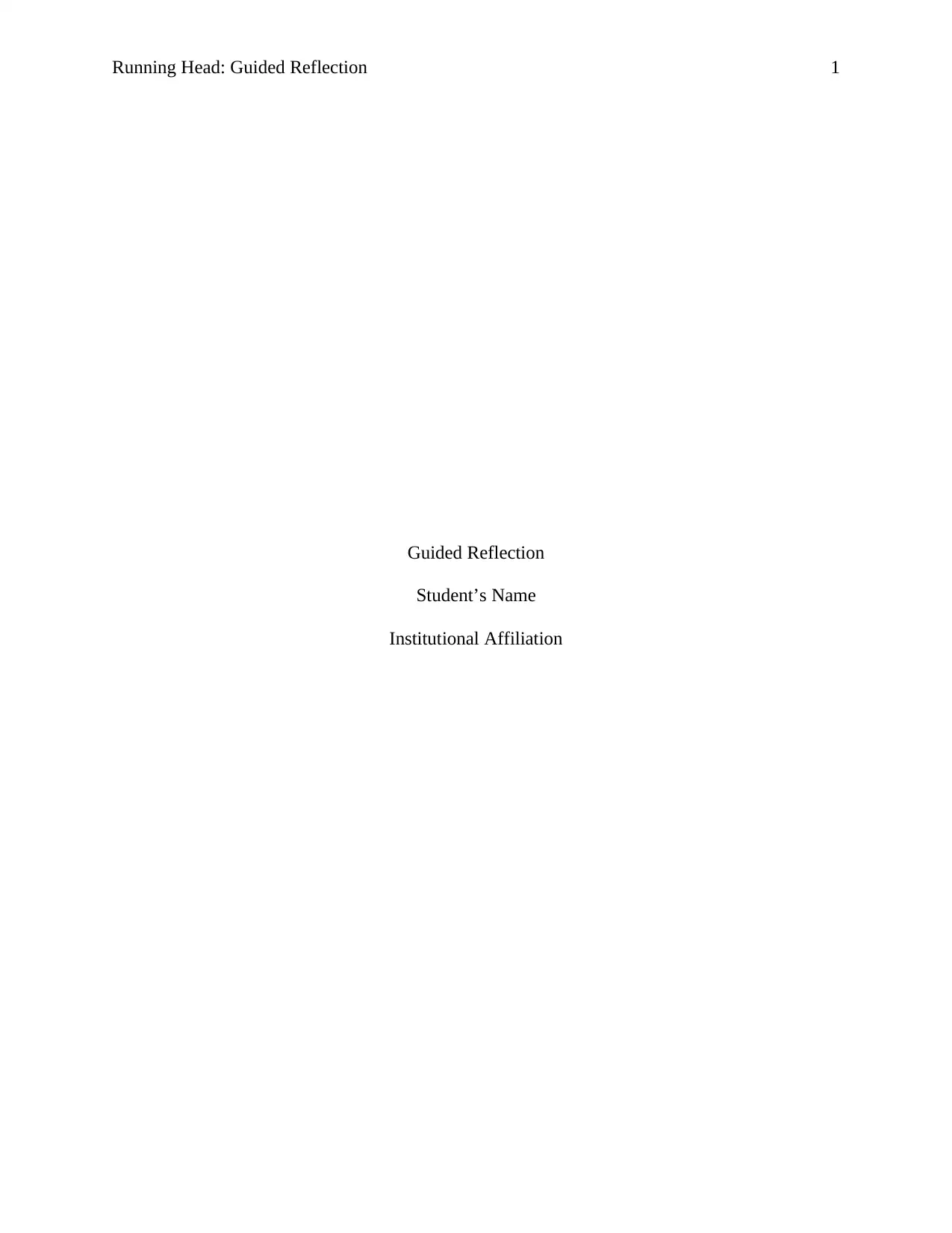
Running Head: Guided Reflection 1
Guided Reflection
Student’s Name
Institutional Affiliation
Guided Reflection
Student’s Name
Institutional Affiliation
Paraphrase This Document
Need a fresh take? Get an instant paraphrase of this document with our AI Paraphraser
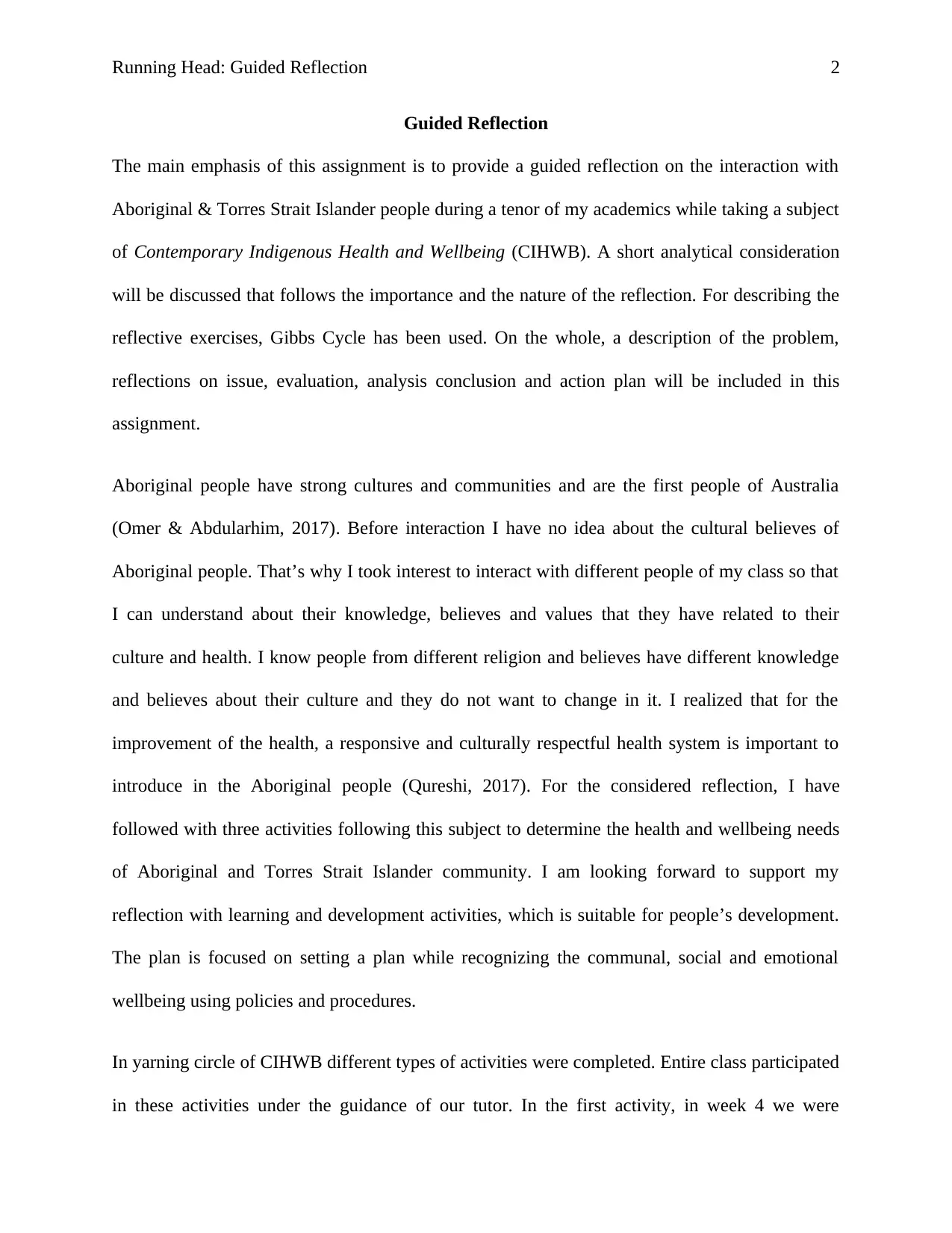
Running Head: Guided Reflection 2
Guided Reflection
The main emphasis of this assignment is to provide a guided reflection on the interaction with
Aboriginal & Torres Strait Islander people during a tenor of my academics while taking a subject
of Contemporary Indigenous Health and Wellbeing (CIHWB). A short analytical consideration
will be discussed that follows the importance and the nature of the reflection. For describing the
reflective exercises, Gibbs Cycle has been used. On the whole, a description of the problem,
reflections on issue, evaluation, analysis conclusion and action plan will be included in this
assignment.
Aboriginal people have strong cultures and communities and are the first people of Australia
(Omer & Abdularhim, 2017). Before interaction I have no idea about the cultural believes of
Aboriginal people. That’s why I took interest to interact with different people of my class so that
I can understand about their knowledge, believes and values that they have related to their
culture and health. I know people from different religion and believes have different knowledge
and believes about their culture and they do not want to change in it. I realized that for the
improvement of the health, a responsive and culturally respectful health system is important to
introduce in the Aboriginal people (Qureshi, 2017). For the considered reflection, I have
followed with three activities following this subject to determine the health and wellbeing needs
of Aboriginal and Torres Strait Islander community. I am looking forward to support my
reflection with learning and development activities, which is suitable for people’s development.
The plan is focused on setting a plan while recognizing the communal, social and emotional
wellbeing using policies and procedures.
In yarning circle of CIHWB different types of activities were completed. Entire class participated
in these activities under the guidance of our tutor. In the first activity, in week 4 we were
Guided Reflection
The main emphasis of this assignment is to provide a guided reflection on the interaction with
Aboriginal & Torres Strait Islander people during a tenor of my academics while taking a subject
of Contemporary Indigenous Health and Wellbeing (CIHWB). A short analytical consideration
will be discussed that follows the importance and the nature of the reflection. For describing the
reflective exercises, Gibbs Cycle has been used. On the whole, a description of the problem,
reflections on issue, evaluation, analysis conclusion and action plan will be included in this
assignment.
Aboriginal people have strong cultures and communities and are the first people of Australia
(Omer & Abdularhim, 2017). Before interaction I have no idea about the cultural believes of
Aboriginal people. That’s why I took interest to interact with different people of my class so that
I can understand about their knowledge, believes and values that they have related to their
culture and health. I know people from different religion and believes have different knowledge
and believes about their culture and they do not want to change in it. I realized that for the
improvement of the health, a responsive and culturally respectful health system is important to
introduce in the Aboriginal people (Qureshi, 2017). For the considered reflection, I have
followed with three activities following this subject to determine the health and wellbeing needs
of Aboriginal and Torres Strait Islander community. I am looking forward to support my
reflection with learning and development activities, which is suitable for people’s development.
The plan is focused on setting a plan while recognizing the communal, social and emotional
wellbeing using policies and procedures.
In yarning circle of CIHWB different types of activities were completed. Entire class participated
in these activities under the guidance of our tutor. In the first activity, in week 4 we were
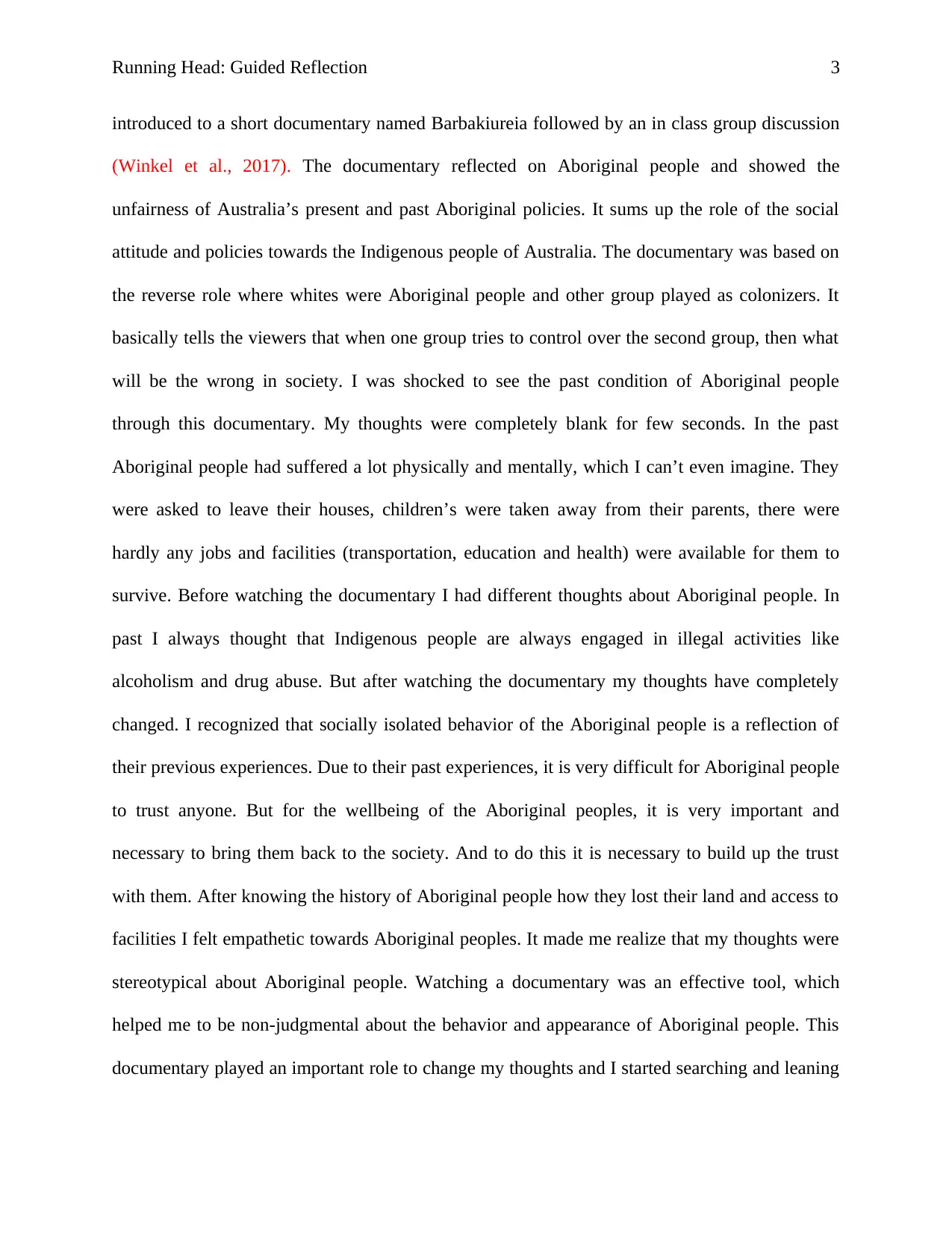
Running Head: Guided Reflection 3
introduced to a short documentary named Barbakiureia followed by an in class group discussion
(Winkel et al., 2017). The documentary reflected on Aboriginal people and showed the
unfairness of Australia’s present and past Aboriginal policies. It sums up the role of the social
attitude and policies towards the Indigenous people of Australia. The documentary was based on
the reverse role where whites were Aboriginal people and other group played as colonizers. It
basically tells the viewers that when one group tries to control over the second group, then what
will be the wrong in society. I was shocked to see the past condition of Aboriginal people
through this documentary. My thoughts were completely blank for few seconds. In the past
Aboriginal people had suffered a lot physically and mentally, which I can’t even imagine. They
were asked to leave their houses, children’s were taken away from their parents, there were
hardly any jobs and facilities (transportation, education and health) were available for them to
survive. Before watching the documentary I had different thoughts about Aboriginal people. In
past I always thought that Indigenous people are always engaged in illegal activities like
alcoholism and drug abuse. But after watching the documentary my thoughts have completely
changed. I recognized that socially isolated behavior of the Aboriginal people is a reflection of
their previous experiences. Due to their past experiences, it is very difficult for Aboriginal people
to trust anyone. But for the wellbeing of the Aboriginal peoples, it is very important and
necessary to bring them back to the society. And to do this it is necessary to build up the trust
with them. After knowing the history of Aboriginal people how they lost their land and access to
facilities I felt empathetic towards Aboriginal peoples. It made me realize that my thoughts were
stereotypical about Aboriginal people. Watching a documentary was an effective tool, which
helped me to be non-judgmental about the behavior and appearance of Aboriginal people. This
documentary played an important role to change my thoughts and I started searching and leaning
introduced to a short documentary named Barbakiureia followed by an in class group discussion
(Winkel et al., 2017). The documentary reflected on Aboriginal people and showed the
unfairness of Australia’s present and past Aboriginal policies. It sums up the role of the social
attitude and policies towards the Indigenous people of Australia. The documentary was based on
the reverse role where whites were Aboriginal people and other group played as colonizers. It
basically tells the viewers that when one group tries to control over the second group, then what
will be the wrong in society. I was shocked to see the past condition of Aboriginal people
through this documentary. My thoughts were completely blank for few seconds. In the past
Aboriginal people had suffered a lot physically and mentally, which I can’t even imagine. They
were asked to leave their houses, children’s were taken away from their parents, there were
hardly any jobs and facilities (transportation, education and health) were available for them to
survive. Before watching the documentary I had different thoughts about Aboriginal people. In
past I always thought that Indigenous people are always engaged in illegal activities like
alcoholism and drug abuse. But after watching the documentary my thoughts have completely
changed. I recognized that socially isolated behavior of the Aboriginal people is a reflection of
their previous experiences. Due to their past experiences, it is very difficult for Aboriginal people
to trust anyone. But for the wellbeing of the Aboriginal peoples, it is very important and
necessary to bring them back to the society. And to do this it is necessary to build up the trust
with them. After knowing the history of Aboriginal people how they lost their land and access to
facilities I felt empathetic towards Aboriginal peoples. It made me realize that my thoughts were
stereotypical about Aboriginal people. Watching a documentary was an effective tool, which
helped me to be non-judgmental about the behavior and appearance of Aboriginal people. This
documentary played an important role to change my thoughts and I started searching and leaning
⊘ This is a preview!⊘
Do you want full access?
Subscribe today to unlock all pages.

Trusted by 1+ million students worldwide
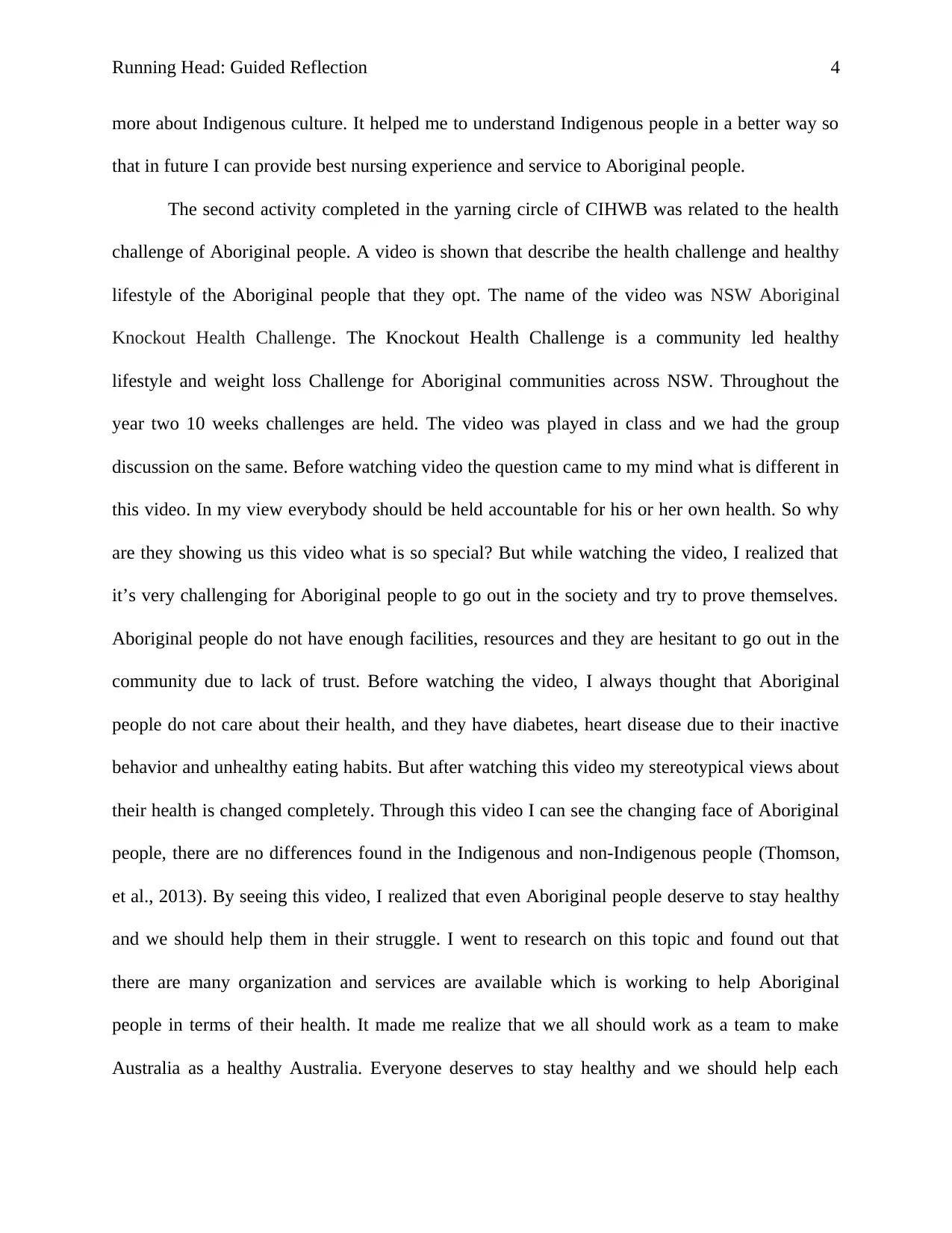
Running Head: Guided Reflection 4
more about Indigenous culture. It helped me to understand Indigenous people in a better way so
that in future I can provide best nursing experience and service to Aboriginal people.
The second activity completed in the yarning circle of CIHWB was related to the health
challenge of Aboriginal people. A video is shown that describe the health challenge and healthy
lifestyle of the Aboriginal people that they opt. The name of the video was NSW Aboriginal
Knockout Health Challenge. The Knockout Health Challenge is a community led healthy
lifestyle and weight loss Challenge for Aboriginal communities across NSW. Throughout the
year two 10 weeks challenges are held. The video was played in class and we had the group
discussion on the same. Before watching video the question came to my mind what is different in
this video. In my view everybody should be held accountable for his or her own health. So why
are they showing us this video what is so special? But while watching the video, I realized that
it’s very challenging for Aboriginal people to go out in the society and try to prove themselves.
Aboriginal people do not have enough facilities, resources and they are hesitant to go out in the
community due to lack of trust. Before watching the video, I always thought that Aboriginal
people do not care about their health, and they have diabetes, heart disease due to their inactive
behavior and unhealthy eating habits. But after watching this video my stereotypical views about
their health is changed completely. Through this video I can see the changing face of Aboriginal
people, there are no differences found in the Indigenous and non-Indigenous people (Thomson,
et al., 2013). By seeing this video, I realized that even Aboriginal people deserve to stay healthy
and we should help them in their struggle. I went to research on this topic and found out that
there are many organization and services are available which is working to help Aboriginal
people in terms of their health. It made me realize that we all should work as a team to make
Australia as a healthy Australia. Everyone deserves to stay healthy and we should help each
more about Indigenous culture. It helped me to understand Indigenous people in a better way so
that in future I can provide best nursing experience and service to Aboriginal people.
The second activity completed in the yarning circle of CIHWB was related to the health
challenge of Aboriginal people. A video is shown that describe the health challenge and healthy
lifestyle of the Aboriginal people that they opt. The name of the video was NSW Aboriginal
Knockout Health Challenge. The Knockout Health Challenge is a community led healthy
lifestyle and weight loss Challenge for Aboriginal communities across NSW. Throughout the
year two 10 weeks challenges are held. The video was played in class and we had the group
discussion on the same. Before watching video the question came to my mind what is different in
this video. In my view everybody should be held accountable for his or her own health. So why
are they showing us this video what is so special? But while watching the video, I realized that
it’s very challenging for Aboriginal people to go out in the society and try to prove themselves.
Aboriginal people do not have enough facilities, resources and they are hesitant to go out in the
community due to lack of trust. Before watching the video, I always thought that Aboriginal
people do not care about their health, and they have diabetes, heart disease due to their inactive
behavior and unhealthy eating habits. But after watching this video my stereotypical views about
their health is changed completely. Through this video I can see the changing face of Aboriginal
people, there are no differences found in the Indigenous and non-Indigenous people (Thomson,
et al., 2013). By seeing this video, I realized that even Aboriginal people deserve to stay healthy
and we should help them in their struggle. I went to research on this topic and found out that
there are many organization and services are available which is working to help Aboriginal
people in terms of their health. It made me realize that we all should work as a team to make
Australia as a healthy Australia. Everyone deserves to stay healthy and we should help each
Paraphrase This Document
Need a fresh take? Get an instant paraphrase of this document with our AI Paraphraser
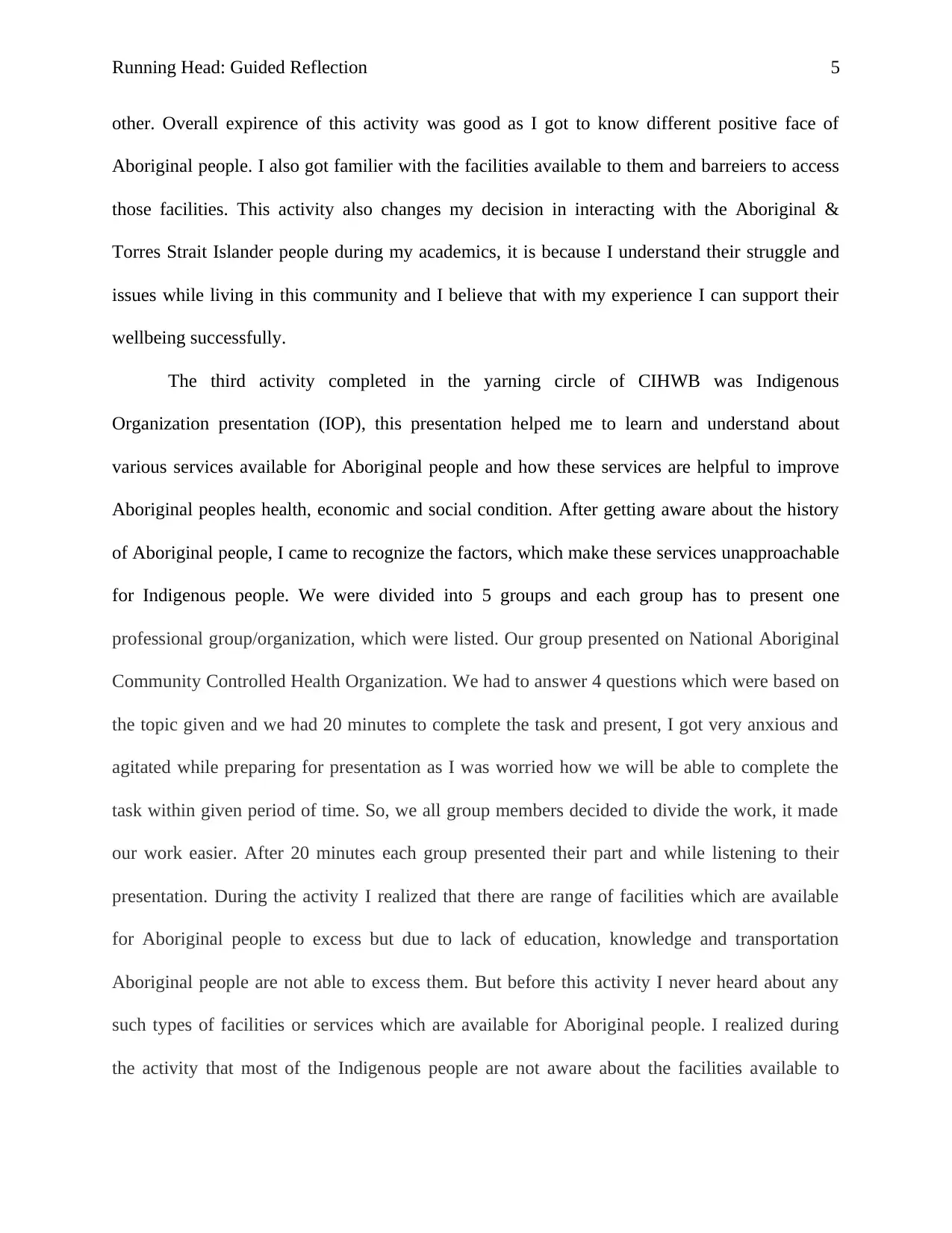
Running Head: Guided Reflection 5
other. Overall expirence of this activity was good as I got to know different positive face of
Aboriginal people. I also got familier with the facilities available to them and barreiers to access
those facilities. This activity also changes my decision in interacting with the Aboriginal &
Torres Strait Islander people during my academics, it is because I understand their struggle and
issues while living in this community and I believe that with my experience I can support their
wellbeing successfully.
The third activity completed in the yarning circle of CIHWB was Indigenous
Organization presentation (IOP), this presentation helped me to learn and understand about
various services available for Aboriginal people and how these services are helpful to improve
Aboriginal peoples health, economic and social condition. After getting aware about the history
of Aboriginal people, I came to recognize the factors, which make these services unapproachable
for Indigenous people. We were divided into 5 groups and each group has to present one
professional group/organization, which were listed. Our group presented on National Aboriginal
Community Controlled Health Organization. We had to answer 4 questions which were based on
the topic given and we had 20 minutes to complete the task and present, I got very anxious and
agitated while preparing for presentation as I was worried how we will be able to complete the
task within given period of time. So, we all group members decided to divide the work, it made
our work easier. After 20 minutes each group presented their part and while listening to their
presentation. During the activity I realized that there are range of facilities which are available
for Aboriginal people to excess but due to lack of education, knowledge and transportation
Aboriginal people are not able to excess them. But before this activity I never heard about any
such types of facilities or services which are available for Aboriginal people. I realized during
the activity that most of the Indigenous people are not aware about the facilities available to
other. Overall expirence of this activity was good as I got to know different positive face of
Aboriginal people. I also got familier with the facilities available to them and barreiers to access
those facilities. This activity also changes my decision in interacting with the Aboriginal &
Torres Strait Islander people during my academics, it is because I understand their struggle and
issues while living in this community and I believe that with my experience I can support their
wellbeing successfully.
The third activity completed in the yarning circle of CIHWB was Indigenous
Organization presentation (IOP), this presentation helped me to learn and understand about
various services available for Aboriginal people and how these services are helpful to improve
Aboriginal peoples health, economic and social condition. After getting aware about the history
of Aboriginal people, I came to recognize the factors, which make these services unapproachable
for Indigenous people. We were divided into 5 groups and each group has to present one
professional group/organization, which were listed. Our group presented on National Aboriginal
Community Controlled Health Organization. We had to answer 4 questions which were based on
the topic given and we had 20 minutes to complete the task and present, I got very anxious and
agitated while preparing for presentation as I was worried how we will be able to complete the
task within given period of time. So, we all group members decided to divide the work, it made
our work easier. After 20 minutes each group presented their part and while listening to their
presentation. During the activity I realized that there are range of facilities which are available
for Aboriginal people to excess but due to lack of education, knowledge and transportation
Aboriginal people are not able to excess them. But before this activity I never heard about any
such types of facilities or services which are available for Aboriginal people. I realized during
the activity that most of the Indigenous people are not aware about the facilities available to
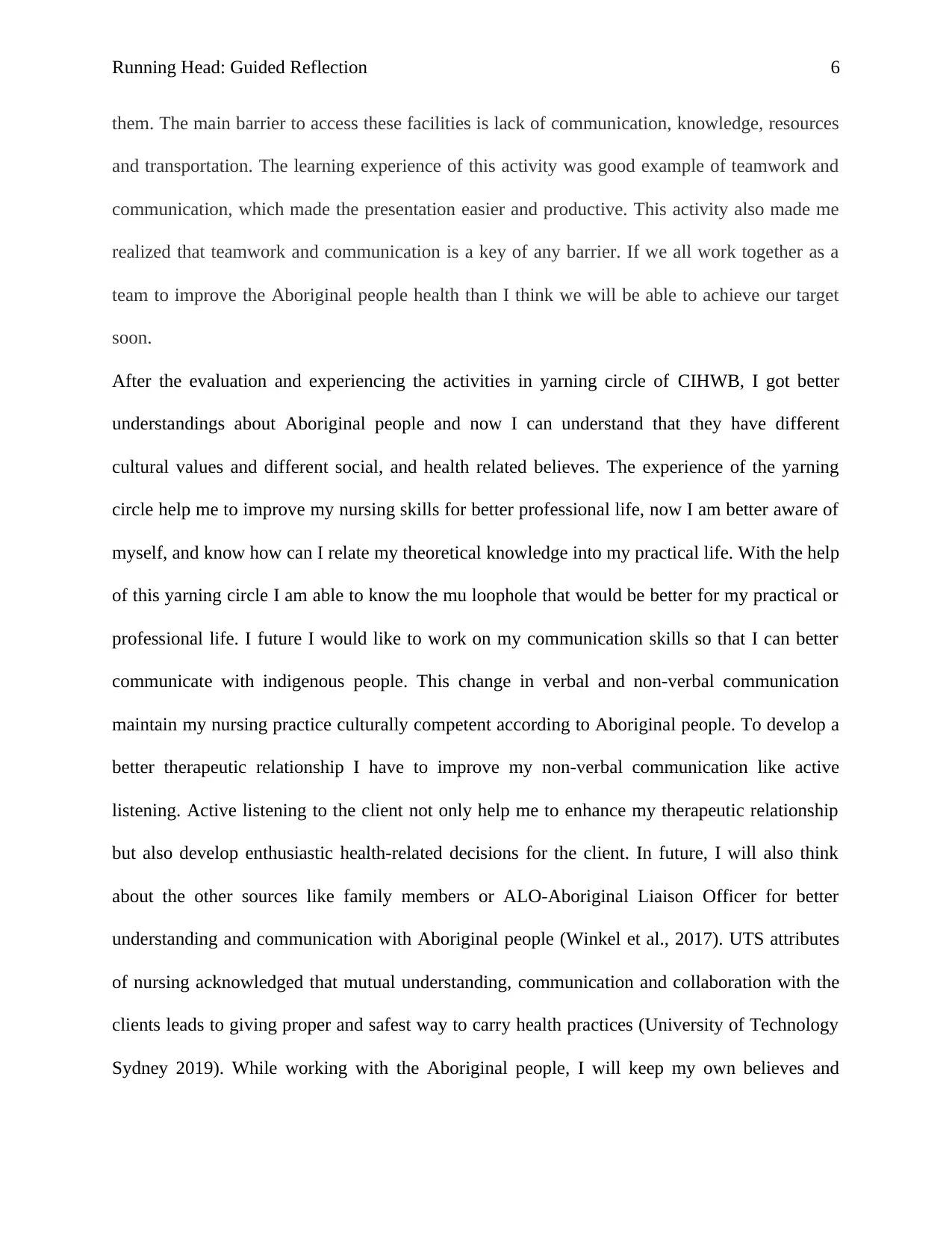
Running Head: Guided Reflection 6
them. The main barrier to access these facilities is lack of communication, knowledge, resources
and transportation. The learning experience of this activity was good example of teamwork and
communication, which made the presentation easier and productive. This activity also made me
realized that teamwork and communication is a key of any barrier. If we all work together as a
team to improve the Aboriginal people health than I think we will be able to achieve our target
soon.
After the evaluation and experiencing the activities in yarning circle of CIHWB, I got better
understandings about Aboriginal people and now I can understand that they have different
cultural values and different social, and health related believes. The experience of the yarning
circle help me to improve my nursing skills for better professional life, now I am better aware of
myself, and know how can I relate my theoretical knowledge into my practical life. With the help
of this yarning circle I am able to know the mu loophole that would be better for my practical or
professional life. I future I would like to work on my communication skills so that I can better
communicate with indigenous people. This change in verbal and non-verbal communication
maintain my nursing practice culturally competent according to Aboriginal people. To develop a
better therapeutic relationship I have to improve my non-verbal communication like active
listening. Active listening to the client not only help me to enhance my therapeutic relationship
but also develop enthusiastic health-related decisions for the client. In future, I will also think
about the other sources like family members or ALO-Aboriginal Liaison Officer for better
understanding and communication with Aboriginal people (Winkel et al., 2017). UTS attributes
of nursing acknowledged that mutual understanding, communication and collaboration with the
clients leads to giving proper and safest way to carry health practices (University of Technology
Sydney 2019). While working with the Aboriginal people, I will keep my own believes and
them. The main barrier to access these facilities is lack of communication, knowledge, resources
and transportation. The learning experience of this activity was good example of teamwork and
communication, which made the presentation easier and productive. This activity also made me
realized that teamwork and communication is a key of any barrier. If we all work together as a
team to improve the Aboriginal people health than I think we will be able to achieve our target
soon.
After the evaluation and experiencing the activities in yarning circle of CIHWB, I got better
understandings about Aboriginal people and now I can understand that they have different
cultural values and different social, and health related believes. The experience of the yarning
circle help me to improve my nursing skills for better professional life, now I am better aware of
myself, and know how can I relate my theoretical knowledge into my practical life. With the help
of this yarning circle I am able to know the mu loophole that would be better for my practical or
professional life. I future I would like to work on my communication skills so that I can better
communicate with indigenous people. This change in verbal and non-verbal communication
maintain my nursing practice culturally competent according to Aboriginal people. To develop a
better therapeutic relationship I have to improve my non-verbal communication like active
listening. Active listening to the client not only help me to enhance my therapeutic relationship
but also develop enthusiastic health-related decisions for the client. In future, I will also think
about the other sources like family members or ALO-Aboriginal Liaison Officer for better
understanding and communication with Aboriginal people (Winkel et al., 2017). UTS attributes
of nursing acknowledged that mutual understanding, communication and collaboration with the
clients leads to giving proper and safest way to carry health practices (University of Technology
Sydney 2019). While working with the Aboriginal people, I will keep my own believes and
⊘ This is a preview!⊘
Do you want full access?
Subscribe today to unlock all pages.

Trusted by 1+ million students worldwide
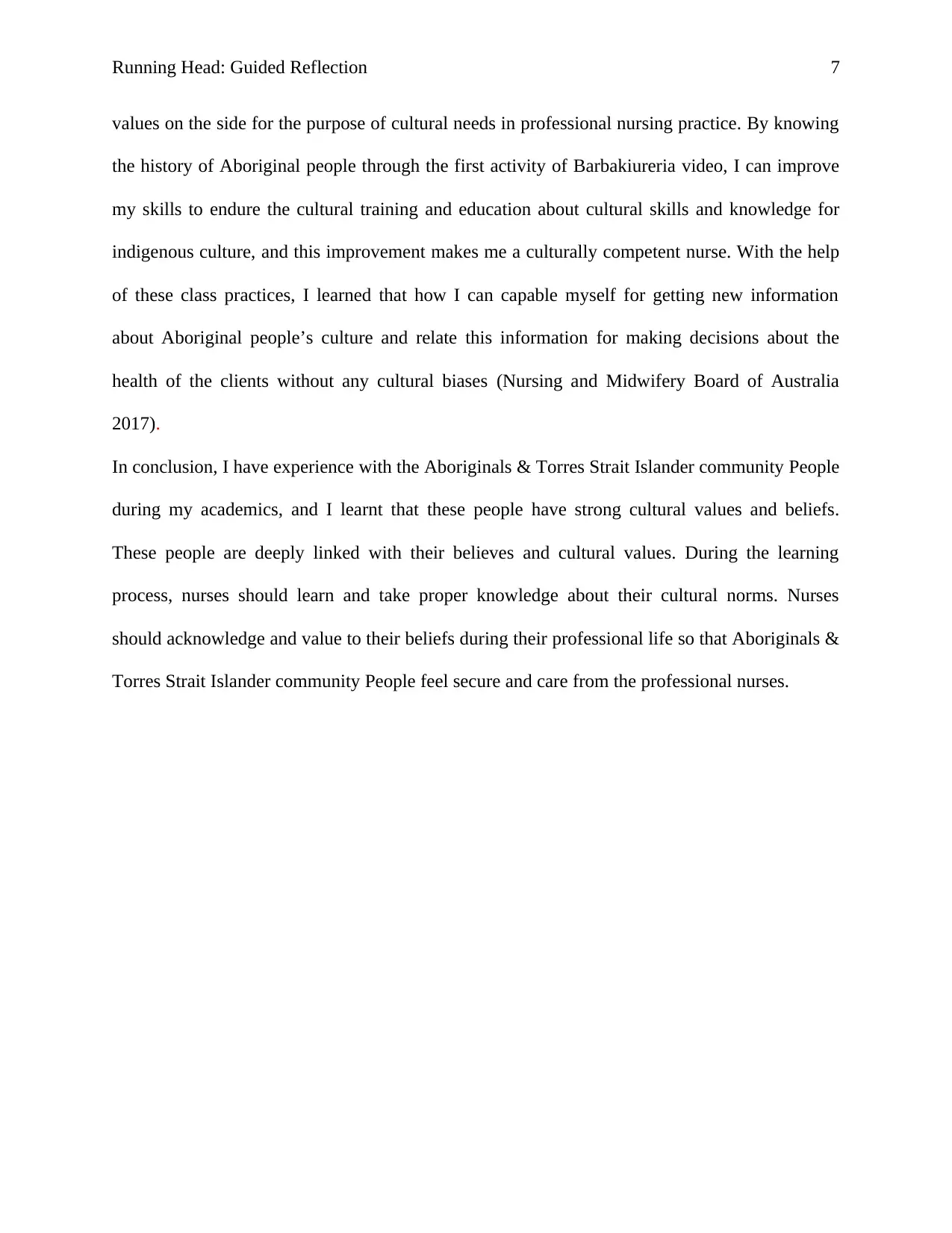
Running Head: Guided Reflection 7
values on the side for the purpose of cultural needs in professional nursing practice. By knowing
the history of Aboriginal people through the first activity of Barbakiureria video, I can improve
my skills to endure the cultural training and education about cultural skills and knowledge for
indigenous culture, and this improvement makes me a culturally competent nurse. With the help
of these class practices, I learned that how I can capable myself for getting new information
about Aboriginal people’s culture and relate this information for making decisions about the
health of the clients without any cultural biases (Nursing and Midwifery Board of Australia
2017).
In conclusion, I have experience with the Aboriginals & Torres Strait Islander community People
during my academics, and I learnt that these people have strong cultural values and beliefs.
These people are deeply linked with their believes and cultural values. During the learning
process, nurses should learn and take proper knowledge about their cultural norms. Nurses
should acknowledge and value to their beliefs during their professional life so that Aboriginals &
Torres Strait Islander community People feel secure and care from the professional nurses.
values on the side for the purpose of cultural needs in professional nursing practice. By knowing
the history of Aboriginal people through the first activity of Barbakiureria video, I can improve
my skills to endure the cultural training and education about cultural skills and knowledge for
indigenous culture, and this improvement makes me a culturally competent nurse. With the help
of these class practices, I learned that how I can capable myself for getting new information
about Aboriginal people’s culture and relate this information for making decisions about the
health of the clients without any cultural biases (Nursing and Midwifery Board of Australia
2017).
In conclusion, I have experience with the Aboriginals & Torres Strait Islander community People
during my academics, and I learnt that these people have strong cultural values and beliefs.
These people are deeply linked with their believes and cultural values. During the learning
process, nurses should learn and take proper knowledge about their cultural norms. Nurses
should acknowledge and value to their beliefs during their professional life so that Aboriginals &
Torres Strait Islander community People feel secure and care from the professional nurses.
Paraphrase This Document
Need a fresh take? Get an instant paraphrase of this document with our AI Paraphraser
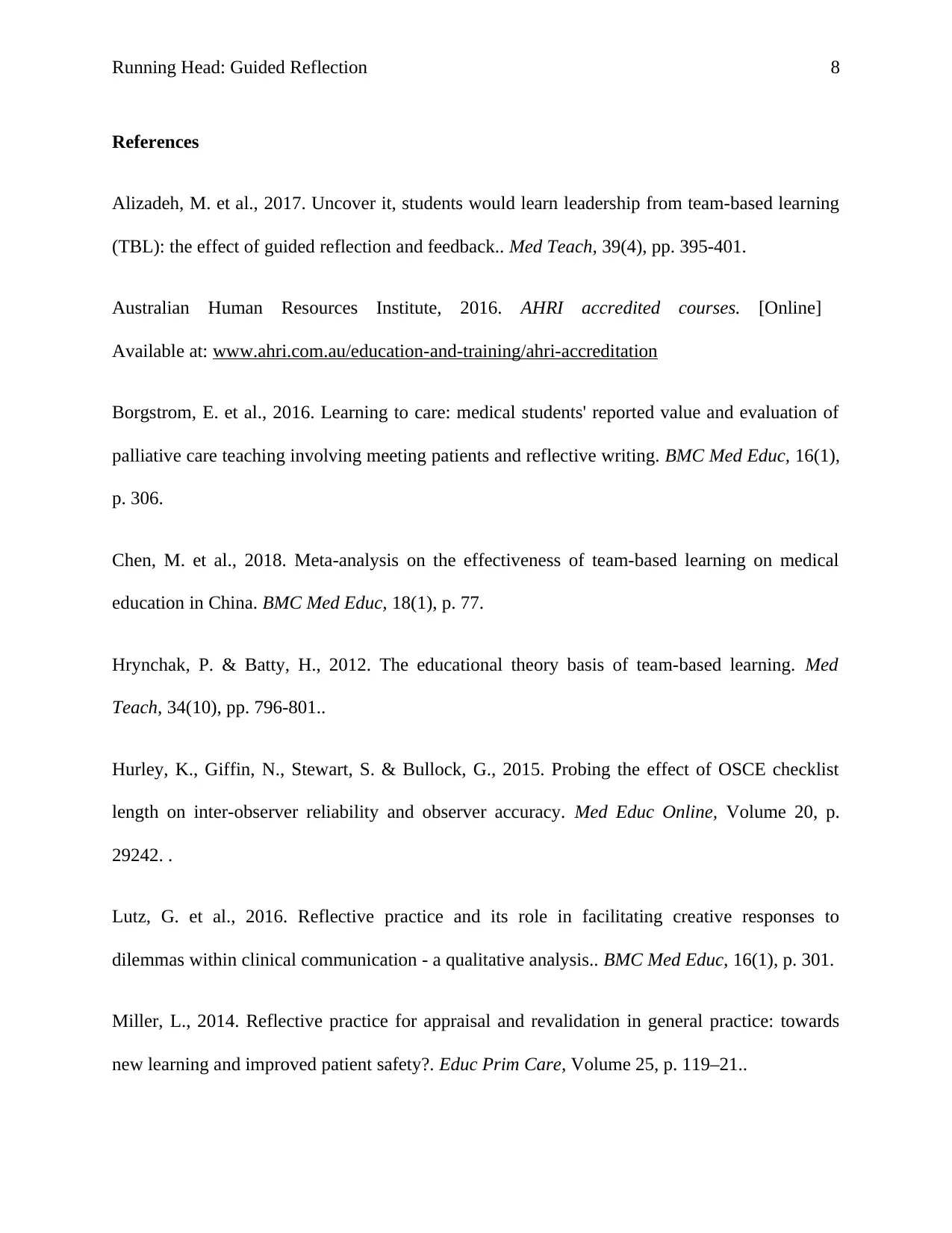
Running Head: Guided Reflection 8
References
Alizadeh, M. et al., 2017. Uncover it, students would learn leadership from team-based learning
(TBL): the effect of guided reflection and feedback.. Med Teach, 39(4), pp. 395-401.
Australian Human Resources Institute, 2016. AHRI accredited courses. [Online]
Available at: www.ahri.com.au/education-and-training/ahri-accreditation
Borgstrom, E. et al., 2016. Learning to care: medical students' reported value and evaluation of
palliative care teaching involving meeting patients and reflective writing. BMC Med Educ, 16(1),
p. 306.
Chen, M. et al., 2018. Meta-analysis on the effectiveness of team-based learning on medical
education in China. BMC Med Educ, 18(1), p. 77.
Hrynchak, P. & Batty, H., 2012. The educational theory basis of team-based learning. Med
Teach, 34(10), pp. 796-801..
Hurley, K., Giffin, N., Stewart, S. & Bullock, G., 2015. Probing the effect of OSCE checklist
length on inter-observer reliability and observer accuracy. Med Educ Online, Volume 20, p.
29242. .
Lutz, G. et al., 2016. Reflective practice and its role in facilitating creative responses to
dilemmas within clinical communication - a qualitative analysis.. BMC Med Educ, 16(1), p. 301.
Miller, L., 2014. Reflective practice for appraisal and revalidation in general practice: towards
new learning and improved patient safety?. Educ Prim Care, Volume 25, p. 119–21..
References
Alizadeh, M. et al., 2017. Uncover it, students would learn leadership from team-based learning
(TBL): the effect of guided reflection and feedback.. Med Teach, 39(4), pp. 395-401.
Australian Human Resources Institute, 2016. AHRI accredited courses. [Online]
Available at: www.ahri.com.au/education-and-training/ahri-accreditation
Borgstrom, E. et al., 2016. Learning to care: medical students' reported value and evaluation of
palliative care teaching involving meeting patients and reflective writing. BMC Med Educ, 16(1),
p. 306.
Chen, M. et al., 2018. Meta-analysis on the effectiveness of team-based learning on medical
education in China. BMC Med Educ, 18(1), p. 77.
Hrynchak, P. & Batty, H., 2012. The educational theory basis of team-based learning. Med
Teach, 34(10), pp. 796-801..
Hurley, K., Giffin, N., Stewart, S. & Bullock, G., 2015. Probing the effect of OSCE checklist
length on inter-observer reliability and observer accuracy. Med Educ Online, Volume 20, p.
29242. .
Lutz, G. et al., 2016. Reflective practice and its role in facilitating creative responses to
dilemmas within clinical communication - a qualitative analysis.. BMC Med Educ, 16(1), p. 301.
Miller, L., 2014. Reflective practice for appraisal and revalidation in general practice: towards
new learning and improved patient safety?. Educ Prim Care, Volume 25, p. 119–21..
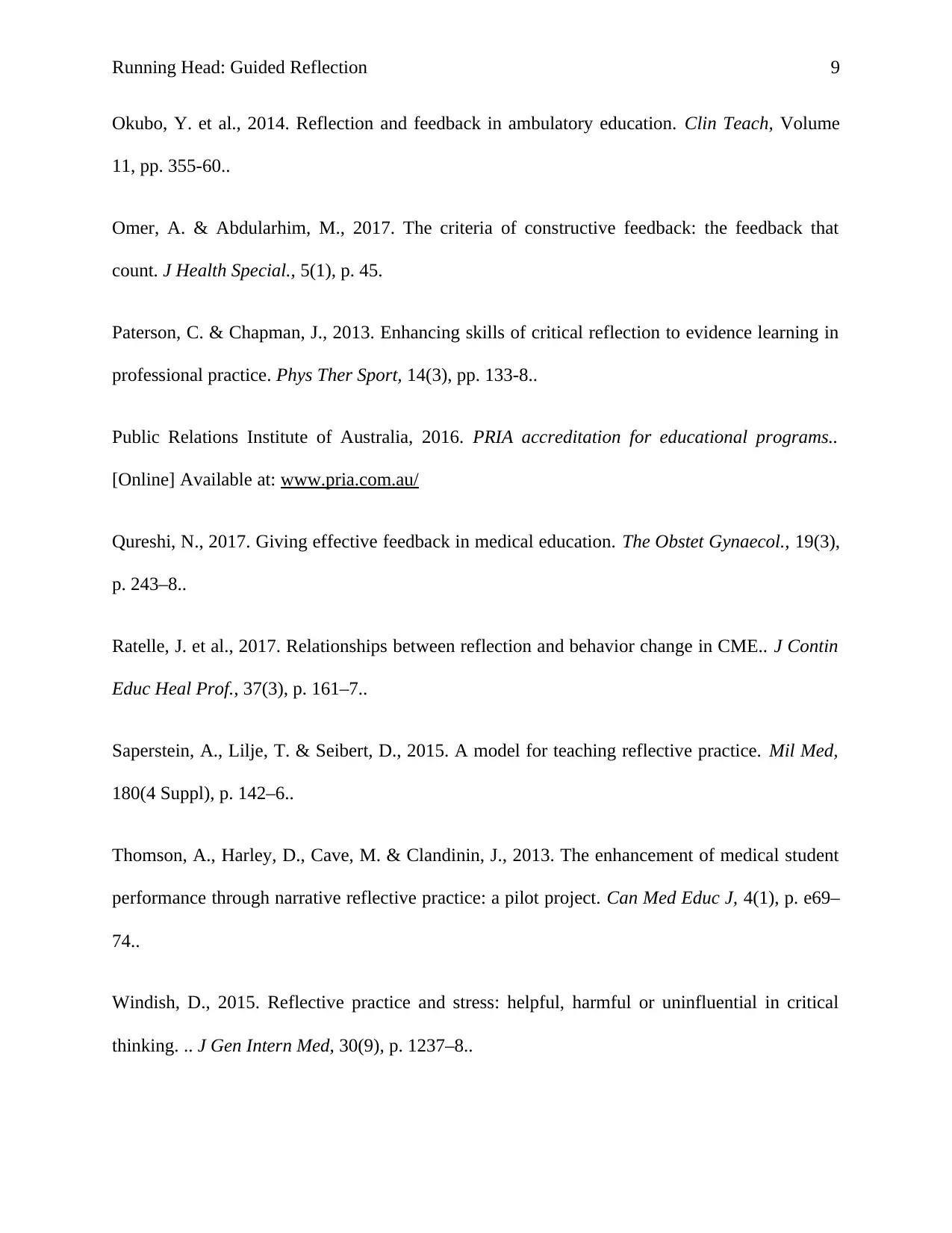
Running Head: Guided Reflection 9
Okubo, Y. et al., 2014. Reflection and feedback in ambulatory education. Clin Teach, Volume
11, pp. 355-60..
Omer, A. & Abdularhim, M., 2017. The criteria of constructive feedback: the feedback that
count. J Health Special., 5(1), p. 45.
Paterson, C. & Chapman, J., 2013. Enhancing skills of critical reflection to evidence learning in
professional practice. Phys Ther Sport, 14(3), pp. 133-8..
Public Relations Institute of Australia, 2016. PRIA accreditation for educational programs..
[Online] Available at: www.pria.com.au/
Qureshi, N., 2017. Giving effective feedback in medical education. The Obstet Gynaecol., 19(3),
p. 243–8..
Ratelle, J. et al., 2017. Relationships between reflection and behavior change in CME.. J Contin
Educ Heal Prof., 37(3), p. 161–7..
Saperstein, A., Lilje, T. & Seibert, D., 2015. A model for teaching reflective practice. Mil Med,
180(4 Suppl), p. 142–6..
Thomson, A., Harley, D., Cave, M. & Clandinin, J., 2013. The enhancement of medical student
performance through narrative reflective practice: a pilot project. Can Med Educ J, 4(1), p. e69–
74..
Windish, D., 2015. Reflective practice and stress: helpful, harmful or uninfluential in critical
thinking. .. J Gen Intern Med, 30(9), p. 1237–8..
Okubo, Y. et al., 2014. Reflection and feedback in ambulatory education. Clin Teach, Volume
11, pp. 355-60..
Omer, A. & Abdularhim, M., 2017. The criteria of constructive feedback: the feedback that
count. J Health Special., 5(1), p. 45.
Paterson, C. & Chapman, J., 2013. Enhancing skills of critical reflection to evidence learning in
professional practice. Phys Ther Sport, 14(3), pp. 133-8..
Public Relations Institute of Australia, 2016. PRIA accreditation for educational programs..
[Online] Available at: www.pria.com.au/
Qureshi, N., 2017. Giving effective feedback in medical education. The Obstet Gynaecol., 19(3),
p. 243–8..
Ratelle, J. et al., 2017. Relationships between reflection and behavior change in CME.. J Contin
Educ Heal Prof., 37(3), p. 161–7..
Saperstein, A., Lilje, T. & Seibert, D., 2015. A model for teaching reflective practice. Mil Med,
180(4 Suppl), p. 142–6..
Thomson, A., Harley, D., Cave, M. & Clandinin, J., 2013. The enhancement of medical student
performance through narrative reflective practice: a pilot project. Can Med Educ J, 4(1), p. e69–
74..
Windish, D., 2015. Reflective practice and stress: helpful, harmful or uninfluential in critical
thinking. .. J Gen Intern Med, 30(9), p. 1237–8..
⊘ This is a preview!⊘
Do you want full access?
Subscribe today to unlock all pages.

Trusted by 1+ million students worldwide
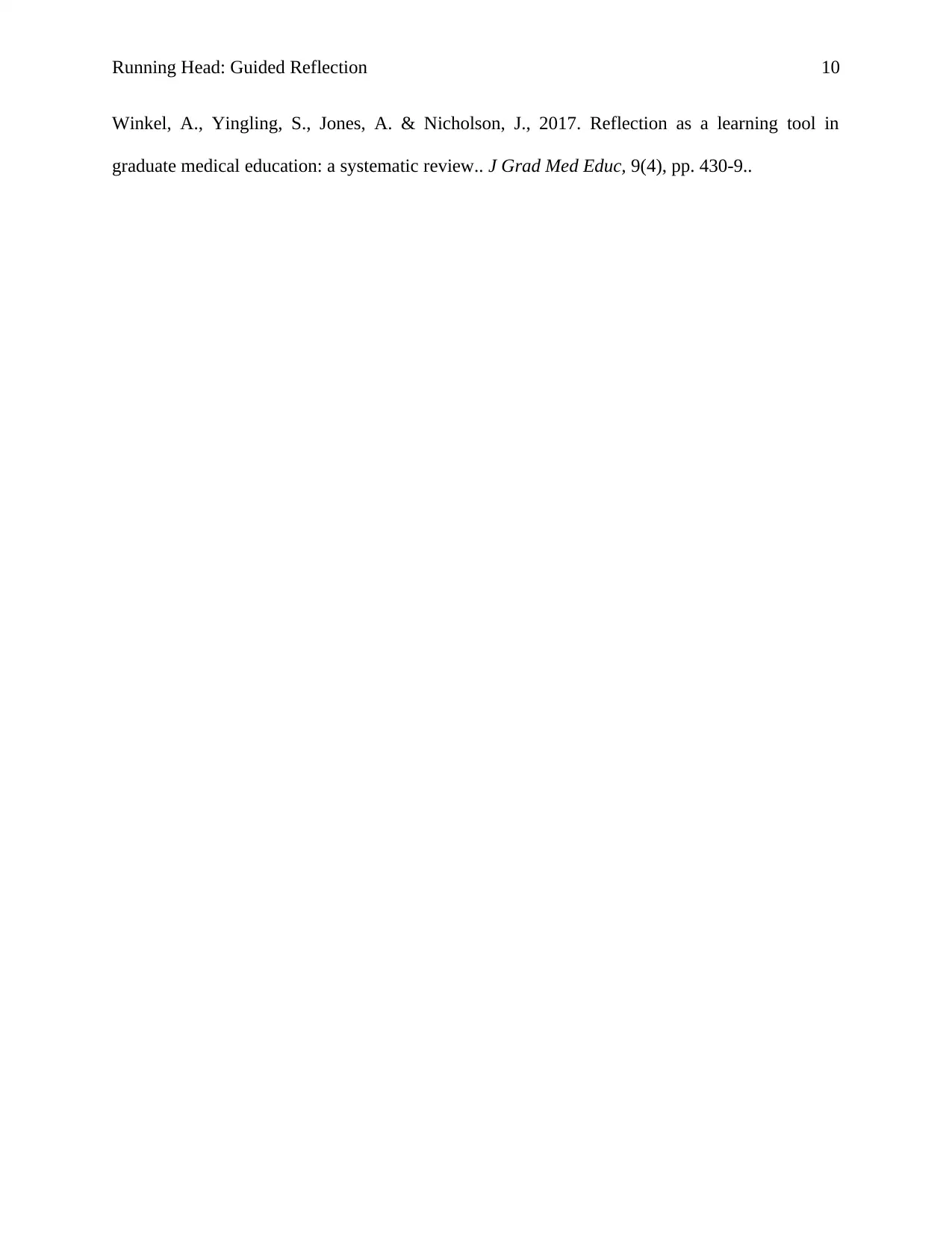
Running Head: Guided Reflection 10
Winkel, A., Yingling, S., Jones, A. & Nicholson, J., 2017. Reflection as a learning tool in
graduate medical education: a systematic review.. J Grad Med Educ, 9(4), pp. 430-9..
Winkel, A., Yingling, S., Jones, A. & Nicholson, J., 2017. Reflection as a learning tool in
graduate medical education: a systematic review.. J Grad Med Educ, 9(4), pp. 430-9..
1 out of 10
Related Documents
Your All-in-One AI-Powered Toolkit for Academic Success.
+13062052269
info@desklib.com
Available 24*7 on WhatsApp / Email
![[object Object]](/_next/static/media/star-bottom.7253800d.svg)
Unlock your academic potential
Copyright © 2020–2025 A2Z Services. All Rights Reserved. Developed and managed by ZUCOL.





